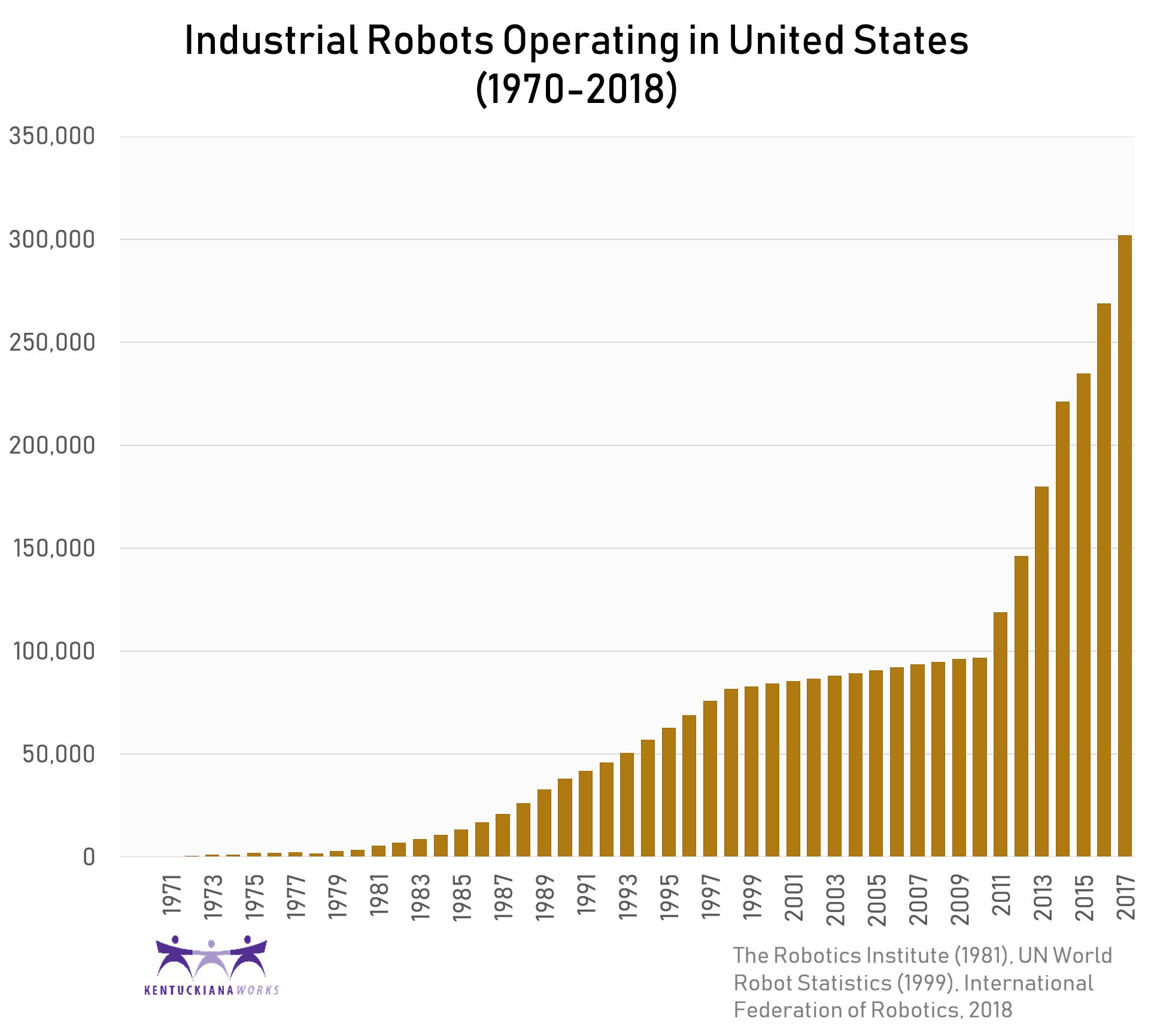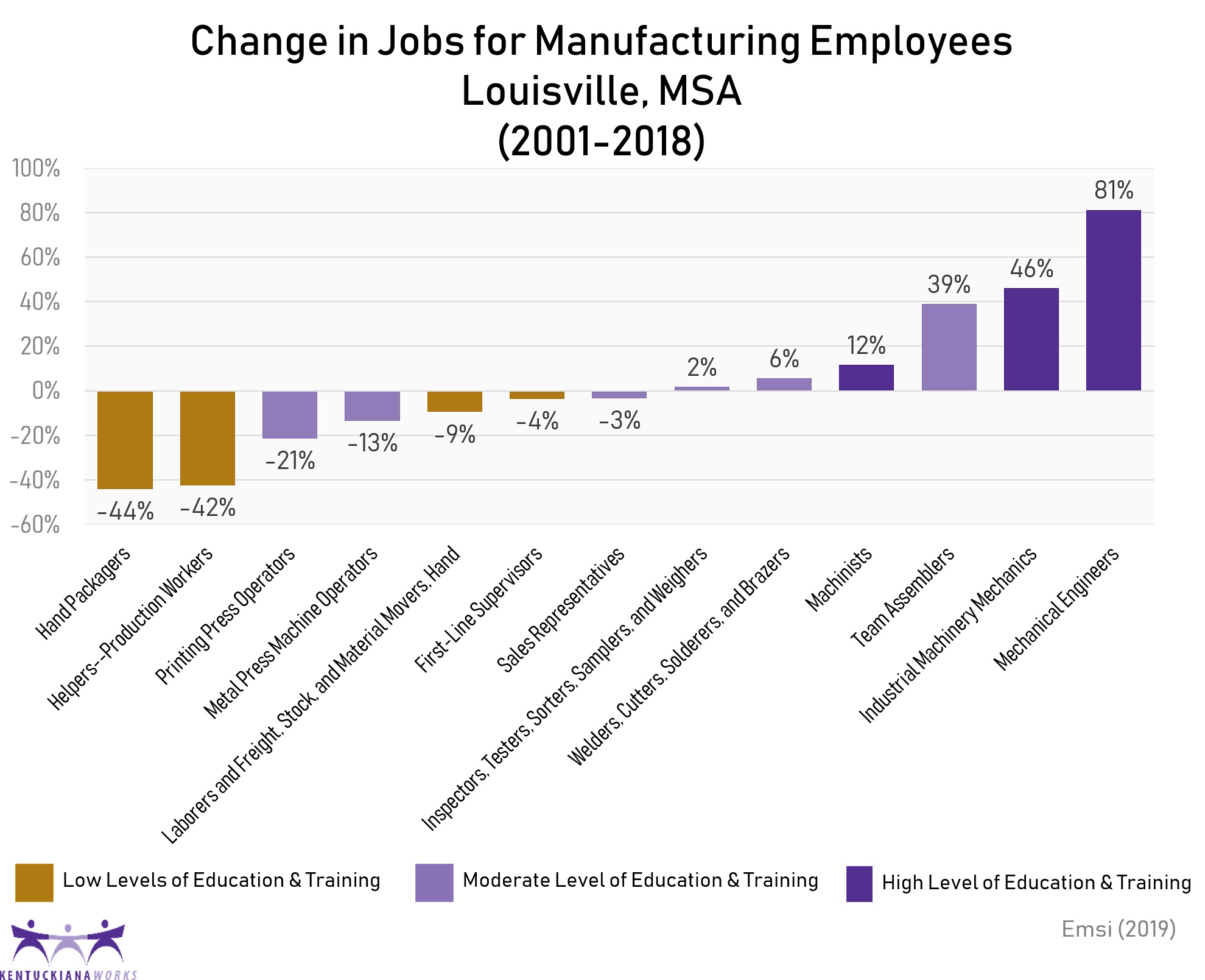What Manufacturing Can Teach Us About How Automation Impacts Jobs
Key Takeaways:
Trade, globalization, and shifts in industrial organization have changed the type of goods produced in the U.S. and indirectly led to automation as advanced manufacturing becomes the standard.
Automation has both positive and negative impacts on jobs. Automation displaces low-skill workers, while providing job opportunities for high-skill workers.
As a result of automation, the production jobs remaining require workers to have more skills than in the past.
One way to determine if a job is automatable is to ask if the tasks completed are routine or non-routine. Routine tasks are repetitive, predictable, and can be accomplished following explicit well understood rules. For example, packagers use their hands to package products and materials. This is a task that is repetitive, predictable, and requires the packager to follow explicit rules to complete (following weight guidelines for the box, ensure packing specifications are met, and recording information on the package, etc.) Because of the nature of routine tasks, technology can easily substitute for human labor in these jobs. Production workers are a classic example of routine workers.
On the other hand, non-routine tasks are comprised of problem-solving, creative thinking, analysis, situational adaptability, and in-person interactions. While routine tasks are likely to be replaced by technology, non-routine tasks are complemented by technology. For example, statistical processing software makes it easier for scientists to analyze the results of their experiments. Digital medical records make it easier for doctors to diagnose their patients. Because non-routine tasks require strong critical thinking, finding new solutions to issues, and emotional intelligence, it is much more difficult for machines and computers to replace these tasks.
Following the end of WWII, the post-war economy saw a boom in the production of consumer goods. Between 1948 and 1973, total employment in manufacturing increased by 71%. At this point in time, manufacturing employed almost a third of all U.S. workers. Total employment in manufacturing would peak in 1979 with over 19 million workers. This would be followed by a gradual decline in manufacturing employment over the next 40 years.
Manufacturing jobs provided many opportunities for workers, especially those without a college degree. Jobs in manufacturing, on average, paid higher wages than other private sector jobs. They were also more likely to offer benefits to employees such as retirement plans, paid vacation, and medical care. The decline in manufacturing employment meant a decrease in middle-class opportunities for less-educated workers.
The manufacturing sector is especially vulnerable to fluctuations in the business cycle, with recessions in the economy hastening the decline of manufacturing jobs. From 1980 to 2000, manufacturing employment remained relatively stable, with between 17 and 18 million people employed in manufacturing jobs. However, beginning in 2000, the U.S. economy began shedding manufacturing jobs at an alarming pace. Between 2000 and 2010, total jobs in the manufacturing sector decreased by 33%.
Several studies have sought to answer what was behind the decline of manufacturing jobs between 1979 and 2010. None of the studies identify automation as the primary factor. Instead, trade, globalization, and shifts in industrial organization are far more influential in explaining manufacturing job loss during that time period. Low-skill workers in labor intensive industries, such as textiles, furniture, apparel, and paper manufacturing were most impacted by these economic shifts because their jobs could be done for far less money by people in lower cost labor markets.
Perhaps the strongest evidence that automation has not fully replaced manufacturing jobs is the percent of the world population employed as manufacturing workers has remained relatively steady over the past 25 years. If automation were completely replacing workers, there would be worldwide decline in manufacturing employment as factories around the globe invest in technology to fully substitute for human labor. Instead declines in manufacturing employment have been primarily concentrated in wealthier countries, where labor is more expensive, while less-developed countries have seen their share of manufacturing employment grow.
The impact of trade, globalization, and shifts in industrial organization on manufacturing goes beyond job loss nationally. The movement and reorganization of labor intensive industries has fundamentally changed the manufacturing sector and how products are produced in the U.S. Advanced manufacturing integrates far more technology into it’s processes than traditional manufacturing including predictive analytics, augmented reality, additive manufacturing (3D printing), and advanced robotics. The introduction this technology into the manufacturing sector has made workers more productive as these technologies improve efficiency and reduce hazards.
Since the Great Recession, the adoption of industrial robots used in U.S. manufacturing has accelerated. In 2010, there were around 96,000 industrial robots in use in the United States, by 2015, this number had more than doubled to just under 235,000. Robots are able to substitute for many tasks in manufacturing and are able to perform those tasks more consistently and efficiently than people. The metal industry, electronics industry, and automotive industry are the chief drivers of this growth.
Automation has made workers more efficient. While employment in manufacturing has declined, output in manufacturing has increased. When firms produce more output with fewer workers they have increased their productivity. Since 1990, output per person, per hour in manufacturing has more than doubled. Technological innovation is one of the drivers of this increase in productivity, however other factors such as product and process improvements also influence productivity.
The impact of automation on employment is both positive and negative. Industrial robots do substitute for tasks that would normally be completed by humans therefore leading to some direct displacement of workers by robots. This displacement manifests by decreasing the demand for workers that can execute routine tasks. For example, a new factory installs industrial robots to spray paint its final product. This factory still needs to hire other workers, but rather than hire many people to spray paint the final product, instead, the industrial robot is capable of doing this. Spray painters are displaced because there is no spray paint job available and they need to find another role in the factory or elsewhere for their employment. Other workers benefit from the new factory which has created jobs for them. Workers without a college degree are particularly impacted by this displacement as the nature of jobs are rapidly restructured. Individuals with higher levels of skills are more likely to face positive outcomes from automation, while those lacking those skills bear many of the negative consequences of this technological adoption.
On the positive side, increased productivity as a result of automation is overall a driver of employment growth. While some workers are displaced, other workers, especially those with a higher level of skill and training are likely to see their employment prospects expanded. There is a strong positive correlation between increased adoption of industrial robots and growth in manufacturing employment within metropolitan statistical areas. This is because while technology displaces some workers, it creates job opportunities for others. The net result of automation is job growth. Increased productivity stimulates demand, which creates jobs along the value chain, including in other sectors such as services.
Exposure to technology has changed the occupational composition of manufacturing employment. Jobs that require more education and training have grown in the past 15 years, while those that require less education and training have declined.
As a result of automation, within manufacturing sector itself, there is a greater premium placed on workers with higher skill levels and abilities. Manufacturing jobs today require multifaceted workers with the ability to engage in problem-solving, critical-thinking, and creativity. Highly skilled production workers are becoming increasingly essential to the operation of factories and plants.
Conclusions
Automation has displaced many low-skilled workers. Many middle-class jobs that would have been available in the past simply do not exist today.
Automation within manufacturing has generally been positive by boosting the productivity of firms.
Increases in productivity have led to job growth, but mostly for high-skilled workers.















